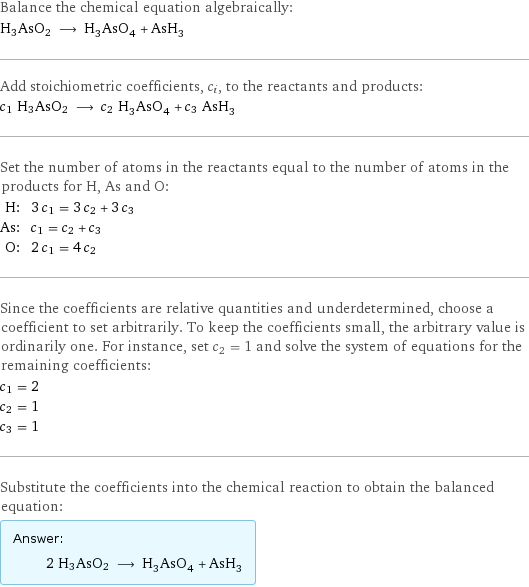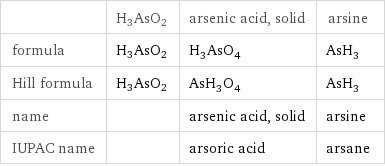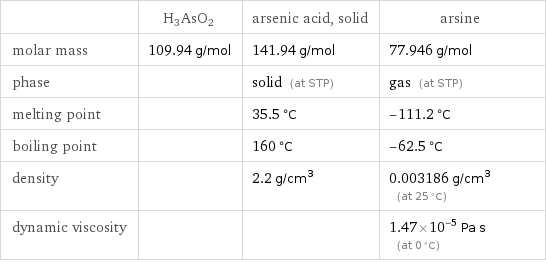Input interpretation

H3AsO2 ⟶ H_3AsO_4 arsenic acid, solid + AsH_3 arsine
Balanced equation

Balance the chemical equation algebraically: H3AsO2 ⟶ H_3AsO_4 + AsH_3 Add stoichiometric coefficients, c_i, to the reactants and products: c_1 H3AsO2 ⟶ c_2 H_3AsO_4 + c_3 AsH_3 Set the number of atoms in the reactants equal to the number of atoms in the products for H, As and O: H: | 3 c_1 = 3 c_2 + 3 c_3 As: | c_1 = c_2 + c_3 O: | 2 c_1 = 4 c_2 Since the coefficients are relative quantities and underdetermined, choose a coefficient to set arbitrarily. To keep the coefficients small, the arbitrary value is ordinarily one. For instance, set c_2 = 1 and solve the system of equations for the remaining coefficients: c_1 = 2 c_2 = 1 c_3 = 1 Substitute the coefficients into the chemical reaction to obtain the balanced equation: Answer: | | 2 H3AsO2 ⟶ H_3AsO_4 + AsH_3
Structures

H3AsO2 ⟶ +
Names

H3AsO2 ⟶ arsenic acid, solid + arsine
Equilibrium constant
![Construct the equilibrium constant, K, expression for: H3AsO2 ⟶ H_3AsO_4 + AsH_3 Plan: • Balance the chemical equation. • Determine the stoichiometric numbers. • Assemble the activity expression for each chemical species. • Use the activity expressions to build the equilibrium constant expression. Write the balanced chemical equation: 2 H3AsO2 ⟶ H_3AsO_4 + AsH_3 Assign stoichiometric numbers, ν_i, using the stoichiometric coefficients, c_i, from the balanced chemical equation in the following manner: ν_i = -c_i for reactants and ν_i = c_i for products: chemical species | c_i | ν_i H3AsO2 | 2 | -2 H_3AsO_4 | 1 | 1 AsH_3 | 1 | 1 Assemble the activity expressions accounting for the state of matter and ν_i: chemical species | c_i | ν_i | activity expression H3AsO2 | 2 | -2 | ([H3AsO2])^(-2) H_3AsO_4 | 1 | 1 | [H3AsO4] AsH_3 | 1 | 1 | [AsH3] The equilibrium constant symbol in the concentration basis is: K_c Mulitply the activity expressions to arrive at the K_c expression: Answer: | | K_c = ([H3AsO2])^(-2) [H3AsO4] [AsH3] = ([H3AsO4] [AsH3])/([H3AsO2])^2](../image_source/425627d4ee5886211272199d6aaf6234.png)
Construct the equilibrium constant, K, expression for: H3AsO2 ⟶ H_3AsO_4 + AsH_3 Plan: • Balance the chemical equation. • Determine the stoichiometric numbers. • Assemble the activity expression for each chemical species. • Use the activity expressions to build the equilibrium constant expression. Write the balanced chemical equation: 2 H3AsO2 ⟶ H_3AsO_4 + AsH_3 Assign stoichiometric numbers, ν_i, using the stoichiometric coefficients, c_i, from the balanced chemical equation in the following manner: ν_i = -c_i for reactants and ν_i = c_i for products: chemical species | c_i | ν_i H3AsO2 | 2 | -2 H_3AsO_4 | 1 | 1 AsH_3 | 1 | 1 Assemble the activity expressions accounting for the state of matter and ν_i: chemical species | c_i | ν_i | activity expression H3AsO2 | 2 | -2 | ([H3AsO2])^(-2) H_3AsO_4 | 1 | 1 | [H3AsO4] AsH_3 | 1 | 1 | [AsH3] The equilibrium constant symbol in the concentration basis is: K_c Mulitply the activity expressions to arrive at the K_c expression: Answer: | | K_c = ([H3AsO2])^(-2) [H3AsO4] [AsH3] = ([H3AsO4] [AsH3])/([H3AsO2])^2
Rate of reaction
![Construct the rate of reaction expression for: H3AsO2 ⟶ H_3AsO_4 + AsH_3 Plan: • Balance the chemical equation. • Determine the stoichiometric numbers. • Assemble the rate term for each chemical species. • Write the rate of reaction expression. Write the balanced chemical equation: 2 H3AsO2 ⟶ H_3AsO_4 + AsH_3 Assign stoichiometric numbers, ν_i, using the stoichiometric coefficients, c_i, from the balanced chemical equation in the following manner: ν_i = -c_i for reactants and ν_i = c_i for products: chemical species | c_i | ν_i H3AsO2 | 2 | -2 H_3AsO_4 | 1 | 1 AsH_3 | 1 | 1 The rate term for each chemical species, B_i, is 1/ν_i(Δ[B_i])/(Δt) where [B_i] is the amount concentration and t is time: chemical species | c_i | ν_i | rate term H3AsO2 | 2 | -2 | -1/2 (Δ[H3AsO2])/(Δt) H_3AsO_4 | 1 | 1 | (Δ[H3AsO4])/(Δt) AsH_3 | 1 | 1 | (Δ[AsH3])/(Δt) (for infinitesimal rate of change, replace Δ with d) Set the rate terms equal to each other to arrive at the rate expression: Answer: | | rate = -1/2 (Δ[H3AsO2])/(Δt) = (Δ[H3AsO4])/(Δt) = (Δ[AsH3])/(Δt) (assuming constant volume and no accumulation of intermediates or side products)](../image_source/e883c9cdc53ae3a3e6742ac3d41089c6.png)
Construct the rate of reaction expression for: H3AsO2 ⟶ H_3AsO_4 + AsH_3 Plan: • Balance the chemical equation. • Determine the stoichiometric numbers. • Assemble the rate term for each chemical species. • Write the rate of reaction expression. Write the balanced chemical equation: 2 H3AsO2 ⟶ H_3AsO_4 + AsH_3 Assign stoichiometric numbers, ν_i, using the stoichiometric coefficients, c_i, from the balanced chemical equation in the following manner: ν_i = -c_i for reactants and ν_i = c_i for products: chemical species | c_i | ν_i H3AsO2 | 2 | -2 H_3AsO_4 | 1 | 1 AsH_3 | 1 | 1 The rate term for each chemical species, B_i, is 1/ν_i(Δ[B_i])/(Δt) where [B_i] is the amount concentration and t is time: chemical species | c_i | ν_i | rate term H3AsO2 | 2 | -2 | -1/2 (Δ[H3AsO2])/(Δt) H_3AsO_4 | 1 | 1 | (Δ[H3AsO4])/(Δt) AsH_3 | 1 | 1 | (Δ[AsH3])/(Δt) (for infinitesimal rate of change, replace Δ with d) Set the rate terms equal to each other to arrive at the rate expression: Answer: | | rate = -1/2 (Δ[H3AsO2])/(Δt) = (Δ[H3AsO4])/(Δt) = (Δ[AsH3])/(Δt) (assuming constant volume and no accumulation of intermediates or side products)
Chemical names and formulas

| H3AsO2 | arsenic acid, solid | arsine formula | H3AsO2 | H_3AsO_4 | AsH_3 Hill formula | H3AsO2 | AsH_3O_4 | AsH_3 name | | arsenic acid, solid | arsine IUPAC name | | arsoric acid | arsane
Substance properties

| H3AsO2 | arsenic acid, solid | arsine molar mass | 109.94 g/mol | 141.94 g/mol | 77.946 g/mol phase | | solid (at STP) | gas (at STP) melting point | | 35.5 °C | -111.2 °C boiling point | | 160 °C | -62.5 °C density | | 2.2 g/cm^3 | 0.003186 g/cm^3 (at 25 °C) dynamic viscosity | | | 1.47×10^-5 Pa s (at 0 °C)
Units
